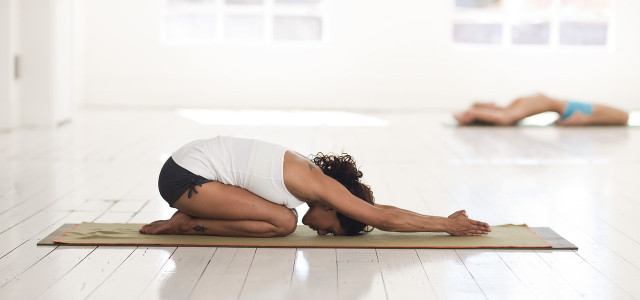What is Bikram yoga? This type of hot yoga focuses on a specific set of postures to build strength and flexibility. But is it good for you? Let’s find out.
What is Bikram yoga? It’s the most known branch of hot yoga, meaning it’s taught in a hot room that is usually heated to 105°F (41°C). This heat is intended to replicate the climate of India. The yoga room is also often fitted with carpets, and the walls are sometimes covered in mirrors.
The poses remain the same with each class. There are 26 poses (called asanas), performed in the same order. The class also includes 2 breathing exercises (called Pranayama). The class lasts 90 minutes and is quite strict in its teaching. The instructor may adjust the students’ yoga postures — see later on whether this may or may not be a good thing.
Bikram yoga is considered one of the first hot yoga practices, from which other branches have derived. The purpose is to build a strong and flexible body, yet also maintain the focus on a healthy mind and personal happiness.
What is Bikram Yoga’s History?
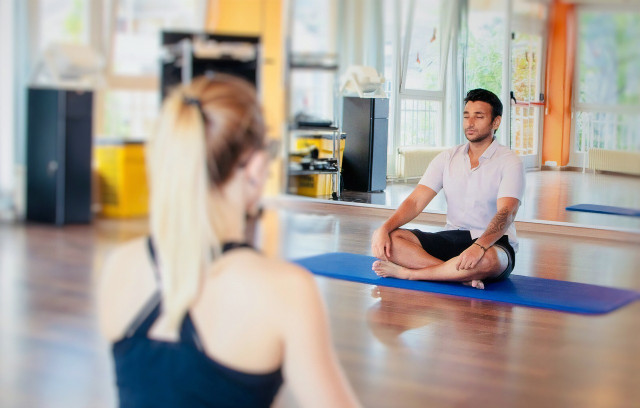
The 26 poses in Bikram Yoga, are all derived from Hatha yoga, believed to be developed by Patanjali (known as the father of yoga), around 4,700 years ago. It is called Bikram yoga after Bikram Choudhury, who brought the idea to the West in the 1970s. He narrowed down Patanjali’s 84 classic Hatha yoga poses to 26, and in a strict Bikram class, these poses are not deviated from.
Bikram yoga became popular very quickly across America and the Western world. At one point there were many studios across a large number of countries. Yet Choudhury’s name was disgraced, and in 2006 he was accused of sexual assault. He fled the US to India, but suggestions are he is now teaching again. Most yoga studios changed their names, and distanced themselves from the man himself, but continued to teach the sequence, which Bikram unsuccessfully tried to copyright after trying to sue a yoga studio in 2011.
Bikram yoga can still be found in many places, yet you may find that teachers offering hot yoga, teach the same, or very similar, style.
Potential Benefits of Bikram Yoga
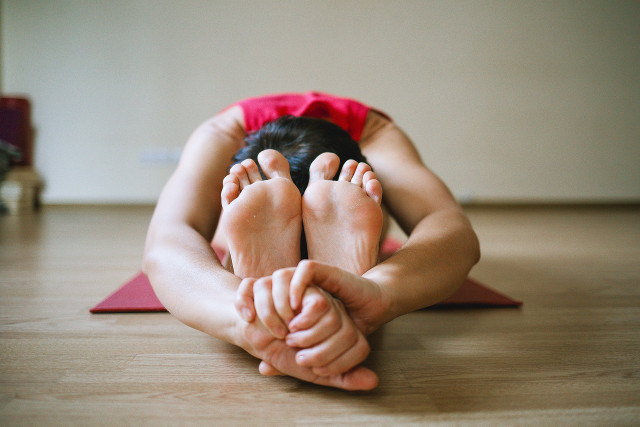


There are many benefits to be gained from practicing Bikram yoga if you are mindful of the practice. However, other types of hot yoga may suit some people better. Let’s take a closer look at the potential benefits:
- Yoga performed in a hot room allows for deep breathing, which oxygenates the blood, allowing the cells to function at an optimal level.
- The poses are very strong so your fitness will likely improve. The practice is very cardiovascular so overall fitness, as well as strength and flexibility, should get a boost.
- You get very familiar with the postures so you know how to work on them, and can track progress.
- It’s a whole-body workout, but also works the mind, as you are challenged.
- The muscles are warm all the way through, so may be less likely to be damaged.
- It’s a high fat-burning practice, so can be effective for weight loss.
- Sweating may help eliminate toxins from the body. As a caveat, it is important to be well-hydrated because of this moisture loss.
- There may be a feeling of elation after finishing such a strong practice. This may lead to feelings of happiness, self-confidence, and possibly less stress.
But are there possible pitfalls along with potential benefits? Yes.
Potential Drawbacks of Bikram Yoga
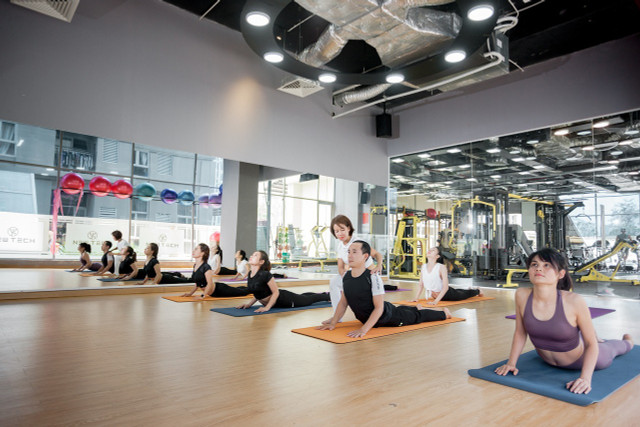


Due to its nature, there are a few potential downsides to practicing Bikram yoga. Therefore if you are looking for a hot yoga class, it may be an idea to try a few different ones, and find the right one for you. Why? These are some of the drawbacks:
- As the class sticks to the 26 poses, you don’t get to practice any of the other yoga asanas. This may suit some people but you could be missing out on the benefits of the range of poses available.
- It can be easy to overdo it. In the hot room, although the muscles are warm, you may think you can do anything. It might be easy to pull muscles because you think you can do it all to perfection. And sometimes a Bikram Yoga teacher will push you to your very limits.
- It’s easy to get dehydrated. In a Bikram yoga class, you can take a water break (usually when instructed) but are advised to take little sips. You may lose a lot of fluid, so it is important that you are hydrated before the class (and we’d advise drinking a little more if needed, during the class).
- It’s not easy. For example, the initial breathing practice involves craning the head back quite far. If you are not used to such movements (and even if you are), this may cause injury.
- You may experience dizziness. There are quite a few inversions (forwards folding, or movement where the head is lower than the heart). As the room is hot, this may add to feeling dizzy. In strict classes, you are advised not to leave the room. Our advice here would be to sit or lie down or leave the room if you need to.
- You may feel breathless. You are working your body hard, so take a time-out if you need one.
Who should avoid Bikram Yoga?
Bikram or other forms of hot yoga isn’t for everyone. We suggest you avoid this type of yoga if you are pregnant, have a heart condition, have high or low blood pressure, or have asthma. As with everything, listen to your body and consult a health care practitioner before starting a new exercise regime.
Bikram Yoga: 10 Tips for Getting Started
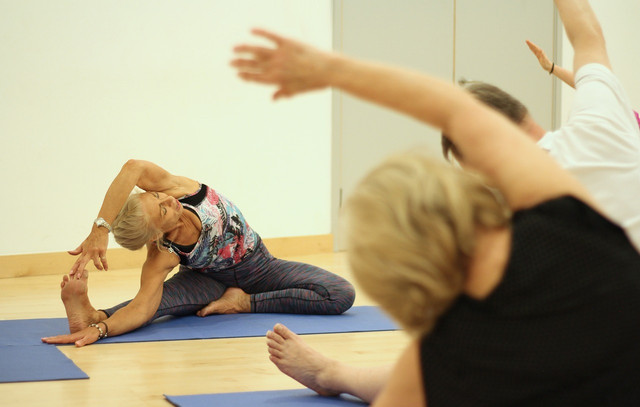


Bikram Yoga can be very challenging, so it may be an idea to be prepared, in more ways than one. Here are our top tips if you are wishing to embark on a Bikram Yoga journey.
- Ease yourself in. If you are new to yoga, take gentle yoga classes first (Hatha or Yin would be a good place to start), then maybe try a few Vinyasa, power yoga, or Ashtanga classes (these are usually stronger than hatha yoga). This will get your body used to some of the movements.
- Don’t compare yourself to others in the class. Some people have been practicing for a long time, others are naturally flexible, etc. Only compete with yourself, and be accepting of what you can and can’t do. Be kind to yourself.
- Give it time. Your first class may surprise you, due to its intensity. Just do what you can.
- You will sweat. Take a towel. Dabbing is better and the sweat will keep you a little cooler.
- Hydrate. It may be a good idea to drink more fluids the day before practice, and earlier than the session.
- Do not practice if you have recently eaten. There are strong twists and inversion so you’ll likely feel sick. Wait at least 2-3 after eating to practice.
- Many people are highly focused, so try to limit any chatter to before or after the class. Otherwise, you will likely disturb people’s mindsets.
- Take an extra towel. You will sweat a lot. But you may also want to wipe down your mat, or even use the extra towel on top of your mat.
- Make the most of the rest poses, called Savasana. Your body and mind need them. Don’t skip them. Be still and rest.
- Don’t wear a lot. Certainly don’t wear sweatpants and a t-shirt. It’s hot, so shorts and a tank top, or bra top will be plenty. Try not to worry, or be self-conscious. Most people have body hang-ups, and everyone else will be focused on the practice, not what anyone else looks like.
And if you find Bikram yoga isn’t for you, maybe try a different hot yoga style. It may be yoga itself isn’t for you, but there are many yoga alternatives you can check out.
Read more:
- 5 Sitting Yoga Poses for Stretching and Strength
- Yoga for Children: Benefits and 4 Beginner Moves
- These Are the 8 Limbs of Yoga Explained
Important Information regarding Health-related Topics.
** Links to retailers marked with ** or underlined orange are partially partner links: If you buy here, you actively support Utopia.org, because we will receive a small part of the sales proceeds. More info.Do you like this post?






